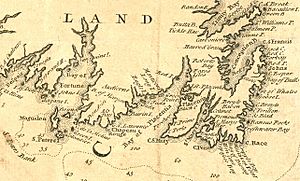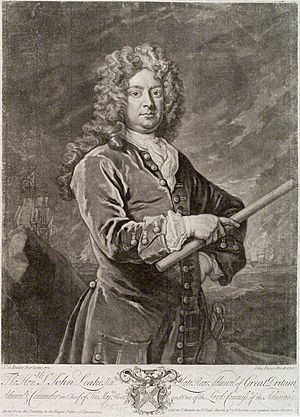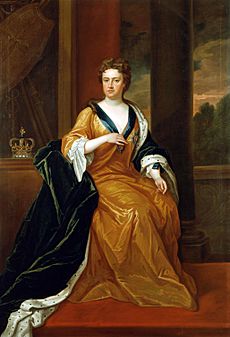Newfoundland expedition (1702) facts for kids
Quick facts for kids Newfoundland expedition |
|||||||
|---|---|---|---|---|---|---|---|
| Part of Queen Anne's War | |||||||
 Extract of a 1744 map showing southeastern Newfoundland |
|||||||
|
|||||||
| Belligerents | |||||||
| Commanders and leaders | |||||||
| Strength | |||||||
| 9 ships | Unknown number of French colonists and militia | ||||||
| Casualties and losses | |||||||
| none | 51 merchantmen captured several merchantmen destroyed |
||||||
The Newfoundland expedition was a naval journey led by English Captain John Leake. It happened between August and October 1702. His goal was to attack French settlements on the island of Newfoundland and nearby Saint Pierre. This expedition took place early in Queen Anne's War. This war was part of a bigger conflict called the War of the Spanish Succession.
Captain Leake's ships attacked French towns along Newfoundland's southern coast. They destroyed fishing areas and other buildings. They also captured many French fishing and trading ships. Most of the settlement at Saint Pierre was destroyed. Before returning to England, Leake's fleet captured more French ships. These ships were part of a convoy heading to Europe. In total, over 50 ships were taken, and six seasonal settlements were ruined. However, the strong French base at Plaisance was not attacked.
Contents
Starting the Expedition
Why England Joined the War
The War of the Spanish Succession began in 1701. England joined the fight in 1702. They planned a big naval attack against Spain. But Newfoundland also became a target. On June 9, 1702, Captain John Leake was chosen to lead a fleet there.
Captain Leake's Mission
Leake's job was to find out how strong the French were in Newfoundland. He was told to "annoy them there in their fishing harbours and at sea." This meant causing trouble for their fishing and shipping. He also had to protect English merchant ships. He was given command of HMS Exeter and a small fleet. On July 22, 1702, he left Plymouth, England. His fleet had nine ships, including six large warships.
Newfoundland's Past Conflicts
Newfoundland had seen many battles before. During King William's War (1689–1697), French forces attacked English settlements. A French leader named Pierre Le Moyne d'Iberville led a very destructive raid in 1696. He destroyed almost all English towns on the island. Many of these towns were rebuilt quickly. The main English port at St. John's was made much stronger.
French Settlements in Newfoundland
There were not many permanent French towns in Newfoundland. Most French settlements, like those in Trepassey Bay and St. Mary's, were only used in summer. Fishermen would come for the season and then return to Europe. The main French town was Plaisance. It had a permanent population and a small army. In 1702, Philippe Pastour de Costebelle was in charge there. The French also had a small town on Saint Pierre island. Its governor, Sébastien Le Gouès, Sieur de Sourdeval, had just arrived in July 1702. He had built a simple wooden fort with a few guns.
Attacks on French Settlements
Raids in Newfoundland

Leake's fleet arrived in late August at Bay Bulls. The local people told them that two French fishing ships were in Trepassey Bay. They also heard that two French warships were near Plaisance. Leake learned that the French often had spies watching Bay Bulls. These spies would likely report his fleet's arrival to Plaisance.
Leake acted quickly. On August 28, his fleet captured its first French ships. They took a ship from Martinique and two ships in Trepassey Bay. The next day, Leake captured another French ship in St. Mary's Bay. His ships destroyed fishing stages, houses, and unfinished ships on land. Fishing stages were platforms used to dry and process fish.
After destroying the facilities at Colinet, the fleet gathered again on August 30. Leake sent some ships to escort captured prizes to St. John's. He also sent ships to destroy the French settlements at St. Lawrence. Leake then sailed towards Saint Pierre.
Attack on Saint Pierre
Leake reached Saint Pierre on September 1. Bad weather stopped him from entering the harbor until the next day. He could only capture two of the eight ships there. The others escaped through a shallow channel. On September 3, he left Saint Pierre and headed for St. John's.
Leake's fleet met up again at St. John's on September 7. He sent half the fleet back to Saint Pierre to destroy it. Leake took the other half north to Bonavista. He hoped to find experienced guides there. These guides would know about other French harbors. He did not find the guides he needed. The guides also worried about the coming winter. So, Leake returned to St. John's. The other half of the fleet joined him on October 2. They had finished destroying Saint Pierre.
Saint Pierre's Governor Sourdeval reported that the English landed men twice. This happened on October 7 and 8. He said 400 English soldiers attacked his small fort. He surrendered after hours of fighting. The English then destroyed most of the buildings. They left 52 French prisoners there and sailed away.
Hunting for the French Convoy
Leake then split his fleet to return to Europe. Some ships escorted merchant ships and prizes to Portugal. Others escorted ships to England. Leake took the rest of the fleet and waited off Cape Race for several weeks. He hoped to catch the French convoy before winter arrived. The weather was often stormy. But Leake managed to capture eight more ships. He finally sailed for England in mid-October.
Results of the Expedition
Leake reported capturing 51 French ships in total. Sixteen ships were sent to England. Six went to Portugal. Five were sold at St. John's. He left two ships at St. John's to help defend it. The remaining ships and their goods were destroyed. Six French settlements were ruined: Trepassey, St. Mary's, Colinet, Great and Little St. Lawrence, and Saint Pierre.
When Leake returned to England, Queen Anne was very pleased. He was promoted to rear admiral for his actions. He continued to have a successful career for the rest of the war.
Newfoundland remained a battleground throughout the war. Both sides attacked each other's settlements. They destroyed fishing areas and other buildings. The main English settlement at St. John's was attacked in 1705. It was captured in 1709 by French forces from Plaisance. The entire island of Newfoundland became British territory in 1713. This was part of the Treaty of Utrecht. However, the French were allowed to dry fish on certain parts of the shore. Saint Pierre also came under British control. But it and nearby Miquelon were later given back to France.
Images for kids



